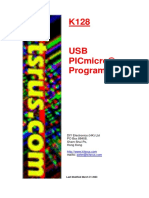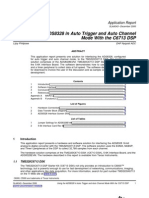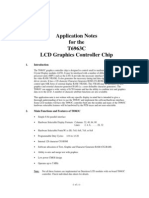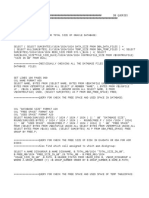Interfacing To A Graphics Module With A Toshiba T6963C Controller
Interfacing To A Graphics Module With A Toshiba T6963C Controller
Uploaded by
Elenilson SampaioCopyright:
Available Formats
Interfacing To A Graphics Module With A Toshiba T6963C Controller
Interfacing To A Graphics Module With A Toshiba T6963C Controller
Uploaded by
Elenilson SampaioOriginal Title
Copyright
Available Formats
Share this document
Did you find this document useful?
Is this content inappropriate?
Copyright:
Available Formats
Interfacing To A Graphics Module With A Toshiba T6963C Controller
Interfacing To A Graphics Module With A Toshiba T6963C Controller
Uploaded by
Elenilson SampaioCopyright:
Available Formats
Application Note
Crystal Clear and Visibly Superior LCD Modules
Interfacing to a Graphics Module with a Toshiba
T6963C Controller
Introduction:
The Toshiba T6963C LCD controller is one of the most popular controllers for use in small graphics
displays. For this reason it is used in a number of Hantronix LCD modules from 128x128 to
240x128 pixels. This class of module is most commonly used to display a mixture of text and
graphics in small devices and instruments. It is usually interfaced directly with an embedded 8-bit
microprocessor. This application note describes the use of this controller with a number of
Hantronix graphics modules. The example used here is based on an 8-bit Intel I8051 micro-
controller but applies to almost any micro-controller.
Functional Description:
The T6963C uses a simple 8-bit data bus to transfer all instructions and data to and from the
display. After power is applied a hardware reset is issued. The controller must then be initialized
with a series of commands to set up the various modes and options available to the user. Once
initialized the display is ready to accept the data to be displayed. This data can be in the form of
bit-mapped graphical data or text data in pseudo ASCII format. The internal character generator is
biased at -20h. which means the user must subtract 20h from the ASCII code before sending it to
the display.
In the bit-mapped mode each byte of data represents 8 pixels on the display. See Figure #1. Text
data can be written in pseudo ASCII format and will be displayed as a 5x7 dot character. The
graphical and text data are written to separate, user assigned, areas, or pages, in the display RAM
within the display module. The user can then choose one of three ways to mix the text and
graphics pages on the display or the text or graphics page can be displayed alone.
1ST BYTE 2ND BYTE
D0 D1 D2 D3 D4 D5 D6 D7 D0 D1
17TH BYTE
Figure #1 Memory map of a 128x128 display
Schematic:
The 80C51 microprocessor is connected to the LCD controller chip via parallel I/O ports in this
example. It could also be connected to the processor's data bus and be mapped into the
processor's data memory area. See figure 2.
Page 1 Copyright2000, Hantronix,Inc.Allrightsreserved
Application Note
Crystal Clear and Visibly Superior LCD Modules
80C51
33pF 240x64LCDDISPLAY +5v
16.00mHz P1.0
X1
VD D -15V
P1.1 D0
D1
FS
X2 P1.2 D2
33pF D3
P1.3 D4 VL 20K
D5
D6 VSS
P1.4
D7
+5v FG
P1.5
1N4148 + WR
1uF RD
P1.6
RST CE
CD
10k P1.7 RESET
P3.0
P3.1
P3.2
P3.3
Figure 2 Schematic diagram
Software:
The sample program here is written in 8051 assembly language and is designed to work with the
hardware shown in Figure 2. It is based on a 240x64 display but is applicable to any Hantronix
graphics display with the T6963C controller.
The program first resets the display. This reset must last a minimum of 2µS. It then sends a series of
command bytes and parameters to the LCD controller to initialize it. The T6963C requires that the
parameters, if any, are sent in the data mode and must precede the command byte, which is sent in
the command mode.
The controller is initialized with the graphics page at 0000-077fh. This is 1920 bytes which will
accommodate a full screen of data. No text is displayed in this example but the controller is
initialized for text operation to illustrate the process. The text page starts immediately following the
graphics page at location 0780h. All Hantronix graphics displays that have a built in T6963C
controller also have 8k of built-in display RAM.
The FS (Font Select) line is set to a zero in this example which will place the 5x7 pixel character in a
8x8 pixel field. This will produce 30 characters per line with 8 lines per display (240
8 =30 ). The total
number of characters possible in this mode is 240. A one on the FS line will produce an 6x8 pixel
field for each character.
After initialization the controller is set in the auto write mode and the display is filled with a bit-
mapped graphic.
The code example is not written to be efficient but to be as simple as possible to follow.
Page 2 Copyright2000, Hantronix,Inc.Allrightsreserved
Application Note
Crystal Clear and Visibly Superior LCD Modules
SEND A BLOCK OF DATA
Software Flowchart: TO THE DISPLAY
MSGD: SEND A
COMMAND
MAIN PROGRAM LOOP WITH
PARAMETERS
START: GET BYTE MSGC:
FROM TABLE
INITIALIZE
T6963C SET COUNTER
TO 2
DISPLAY CALL GET BYTE
BITMAP WRITED FROM TABLE
END INC. TABLE YES END
POINTER RETURN BYTE?
NO
WRITE A WRITE A STATUS CHECK CALL
COMMAND BYTE DATA BYTE
WRITED
STATUS:
WRITEC: WRITED:
INC. TABLE
POINTER
SET C/D TO 1
STATUS STATUS
OK? NO OK? NO
YES YES DECREMENT
RD LOW COUNTER
SET C/D TO 1 SET C/D TO 0
CNT =
READ BYTE 0? NO
DATA TO P1 YES
RDHIGH GET COMM.
FROM TABLE
WR LOW
STATUS CALL
OK? NO WRITEC
WRHIGH
YES
RETURN
RETURN
Page 3 Copyright2000, Hantronix,Inc.Allrightsreserved
Application Note
Crystal Clear and Visibly Superior LCD Modules
Initialization:
Before the LCD controller can accept or display data or text it must be initialized. This is usually
done immediately after the system is powered up. The following chart lists the initialization
commands and the parameters that accompany them along with a brief explanation of the function
of each. Where a parameter is different for a display that differs in resolution from the 240x64
example, the alternate values are also listed.
Initialization bytes:
COMMAND CODE PARAMETERS* FUNCTION
START OF THE TEXT STORAGE AREA IN DISPLAY RAM
TEXT HOME ADDRESS 40h 80h, 07h 0780h
1eh, 00h LINE LENGTH IN CHARACTERS 240 = 30 = 1eh FOR AN
8
(240x128, 240x64) 8 BIT CHARACTER CELL (FS=0). (28h FOR FS=1)
TEXT AREA 41h 14h, 00h LINE LENGTH IN CHARACTERS 160 = 20 = 14h FOR AN
8
(160x128) 8 BIT CHARACTER CELL (FS=0). (1ah FOR FS=1)
10h, 00h LINE LENGTH IN CHARACTERS 1288
= 16 = 10h FOR AN
(128x128) 8 BIT CHARACTER CELL (FS=0). (15h FOR FS=1)
GRAPHIC HOME ADDRESS 42h 00h, 00h START OF THE GRAPHICS STORAGE AREA IN DISPLAY
RAM 0000h
1eh, 00h LINE LENGTH IN PIXELS 240 = 30 = 1eh
8
(240x128, 240x64)
GRAPHIC AREA 43h 14h, 00h LINE LENGTH IN PIXELS 160 = 20 = 14h
(160x128) 8
10h, 00h LINE LENGTH IN PIXELS 128 = 16 = 10h
(128x128) 8
"EXOR" TEXT MODE
MODE SET 81h
ADDRESS POINTER SET LOCATION OF NEXT DATA WRITE (OR READ)
24h 00h, 00h
IN THIS CASE THE BEGINNING OF THE GRAPHICS AREA
TEXT OFF, GRAPHICS ON
DISPLAY MODE SET 98h
* ADDRESSES AREFORMATTEDAS [LSB,MSB]
Displayed image:
Page 4 Copyright2000, Hantronix,Inc.Allrightsreserved
Application Note
Crystal Clear and Visibly Superior LCD Modules
Software: inc dptr
djnz r0,msgc2
clr a
movc a,@a+dptr ;get command
$mod51 mov r1,a
; ************************************************** lcall writec ;send command
; * * sjmp msgc ;next command
; * T6963 Application Note V1.0 *
; * *
; ************************************************** ; MSGD sends the data pointed to by
; the DPTR to the graphics module.
; The processor clock speed is 16MHz.
; Cycle time is .750mS. msgd:
; Demo software to display a bit-mapped clr a
; graphic on a 240x64 graphics display movc a,@a+dptr ;get byte
; with a T6963C LCD controller. cjne a,#0a1h,msgd1 ;done?
ret
msgd1:
mov r1,a
org 000h lcall writed ;send data
ljmp start ;program start inc dptr
sjmp msgd
org 100h
; WRITEC sends the byte in R1 to a
; graphics module as a command.
start:
writec:
; Initialize the T6963C lcall status ;display ready?
setb p3.2 ;c/d = 1
clr p3.3 ;hardware reset writec1:
nop mov p1,r1 ;get data
nop clr p3.0 ;strobe it
setb p3.3 setb p3.0
mov dptr,#msgi1 ;initialization bytes ret
lcall msgc
; WRITED sends the byte in R1 to the
; Start of regular program ; graphics module as data.
; Display graphic writed:
mov dptr,#msgi2 ;set auto mode lcall status ;display ready?
lcall msgc clr p3.0 ;c/d = 0
mov dptr,#msg1 ;display graphic sjmp writec1
lcall msgd
sjmp $ ; STATUS check to see that the graphic
; display is ready. It won't return
;************************************************* ; until it is.
;SUBROUTINES
status:
; MSGC sends the data pointed to by setb p3.2 ;c/d=1
; the DPTR to the graphics module mov p1,#0ffh ;P1 to input
; as a series of commands with mov r3,#0bh ;status bits mask
; two parameters each. stat1:
clr p3.1 ;read it
mov a,p1
msgc: setb p3.1
mov r0,#2 ;# of data bytes anl a,r3 ;status OK?
msgc2: clr c
clr a subb a,r3
movc a,@a+dptr ;get byte jnz stat1
cjne a,#0a1h,msgc3 ;done? ret
ret
msgc3: mov r1,a
lcall writed ;send it
Page 5 Copyright2000, Hantronix,Inc.Allrightsreserved
Application Note
Crystal Clear and Visibly Superior LCD Modules
;************************************************
; TABLES AND DATA
; Initialization bytes for 240x64
msgi1:
db 80h,07h,40h ;text home address
db 1eh,00,41h ;text area
db 00,00,42h ;graphic home address
db 1eh,00,43h ;graphic area
db 00,00,81h ;mode set
db 00,00,24h ;address pointer set
db 00,00,98h ;display mode set
db 0a1h
msgi2:
db 00,00,0b0h ;auto mode
db 0a1h
;240x64 Bitmap graphic data
;Only the first 8 bytes are shown here
;The real graphic consists of 1920 bytes
;of binary data.
msg1:
db 00h,00h,00h,00h,00h,00h,00h,00h
db 0a1h
end
Page 6 Copyright2000, Hantronix,Inc.Allrightsreserved
You might also like
- Evelyn Vine Be Mine PDFDocument2 pagesEvelyn Vine Be Mine PDFJim0% (3)
- Layout Tips For 12-Bit AD Converter Application PDFDocument7 pagesLayout Tips For 12-Bit AD Converter Application PDFGeoFurriel100% (1)
- ANalysis of NetflixDocument8 pagesANalysis of NetflixRonit VermaNo ratings yet
- Computer Science Revision Notes Paper 1Document30 pagesComputer Science Revision Notes Paper 1Dinesh KumarNo ratings yet
- Aruba Wlan 101Document41 pagesAruba Wlan 101Ichwan SetiawanNo ratings yet
- HX8218-A 960CH TFT LCD Source Driver With Built-In TCON: Preliminary Version 01 January 2005Document48 pagesHX8218-A 960CH TFT LCD Source Driver With Built-In TCON: Preliminary Version 01 January 2005GiancarloRichardRivadeneyraMirandaNo ratings yet
- HD 61202Document5 pagesHD 61202kalangeNo ratings yet
- AT yuyuSEICOS 2Document5 pagesAT yuyuSEICOS 2Patryk MarczewskiNo ratings yet
- User Manual 8051Document46 pagesUser Manual 8051sandeep sNo ratings yet
- Ap1601820 C167CS-32FM TFT-DisplayDocument52 pagesAp1601820 C167CS-32FM TFT-Displayشادي العمرNo ratings yet
- Arm7 LPC2148 1Document48 pagesArm7 LPC2148 1Roberta Fisher100% (2)
- Objective:: Lab#7: Introduction To Kit SSUET/QR/114Document6 pagesObjective:: Lab#7: Introduction To Kit SSUET/QR/114Faraz AbbasNo ratings yet
- Pantalla Informacion Via CANDocument23 pagesPantalla Informacion Via CANMicael FigueiraNo ratings yet
- DEM 16101 TGH: LCD ModuleDocument12 pagesDEM 16101 TGH: LCD ModuleZhivko Georgiev TerzievNo ratings yet
- DatasheetDocument12 pagesDatasheetsanseh20019016No ratings yet
- Manual Mother Board Ecs 61Document42 pagesManual Mother Board Ecs 61ajha6775% (4)
- User Manual - 8051Document46 pagesUser Manual - 8051shashanknaik109No ratings yet
- Sample Appkit:: Using The Tsm6755 Led DisplayDocument4 pagesSample Appkit:: Using The Tsm6755 Led DisplayYoandy PerezNo ratings yet
- Mainboard ESC Model P4M800PRO MDocument29 pagesMainboard ESC Model P4M800PRO MHo Thanh BinhNo ratings yet
- Soft Microcontroller Module: Features Pin AssignmentDocument19 pagesSoft Microcontroller Module: Features Pin AssignmentLola Carmona MartinezNo ratings yet
- LAB1Document42 pagesLAB1farheen khosoNo ratings yet
- RS-232/USB Serial Interface Module: Installation InstructionsDocument14 pagesRS-232/USB Serial Interface Module: Installation InstructionsEdgar Giovanny GomezNo ratings yet
- User Manual 8051Document45 pagesUser Manual 8051Charan ANo ratings yet
- HMT070ETD-1D: LCD Module User ManualDocument34 pagesHMT070ETD-1D: LCD Module User ManualAgusNo ratings yet
- Data Sheet: Graphics Displays and Interface/adaptor CardsDocument8 pagesData Sheet: Graphics Displays and Interface/adaptor CardsSergey DNo ratings yet
- Fujitsu Lifebook lh531 Inventec Strike ms14 Rev x01 SCHDocument56 pagesFujitsu Lifebook lh531 Inventec Strike ms14 Rev x01 SCHvisa uk 1No ratings yet
- Acer Chromebook C730 Quanta ZHQ v1.0 PDFDocument48 pagesAcer Chromebook C730 Quanta ZHQ v1.0 PDFdavid pintoNo ratings yet
- HP Compaq nx6120 Inventec DavosFF Shematic Diagram A08Document65 pagesHP Compaq nx6120 Inventec DavosFF Shematic Diagram A08Charly NitroNo ratings yet
- An 908Document7 pagesAn 908dcastrelos2000No ratings yet
- Lbook SKU32 Tablet - QUANTA NL2 - REV 1ADocument35 pagesLbook SKU32 Tablet - QUANTA NL2 - REV 1AaleffalcaoNo ratings yet
- Series Mini Touch Screen: ElectronicDocument41 pagesSeries Mini Touch Screen: ElectronicnenadjanNo ratings yet
- Ceng-280 Microprocessors: Programming Project 2Document6 pagesCeng-280 Microprocessors: Programming Project 2kwstas vrotzisNo ratings yet
- Hkt043ata 1CDocument31 pagesHkt043ata 1Cmihir.prestigeNo ratings yet
- TS1620 TechstarDocument12 pagesTS1620 TechstarMahdiiiiii83No ratings yet
- Version 0A: Digitally Signed by Nhat Tin DN: CN Nhat Tin, O, Ou, Email Support@kythua Date: 2010.01.08 11:48:44 +07'00'Document36 pagesVersion 0A: Digitally Signed by Nhat Tin DN: CN Nhat Tin, O, Ou, Email Support@kythua Date: 2010.01.08 11:48:44 +07'00'poupounNo ratings yet
- Intersil fn4584Document10 pagesIntersil fn4584Hoii ClarkNo ratings yet
- Temp Sensor LM35 Interfacing With ARM7 TyroDocument12 pagesTemp Sensor LM35 Interfacing With ARM7 TyroÉderson BertiNo ratings yet
- 5X7 Dot Character VFD Module CU40025SCPB-W6JDocument1 page5X7 Dot Character VFD Module CU40025SCPB-W6Jjohn jairoNo ratings yet
- Ecs h55h-m Rev1.0 PDFDocument28 pagesEcs h55h-m Rev1.0 PDFanandaNo ratings yet
- Sample 7489Document11 pagesSample 7489kpatil9887No ratings yet
- LMB 162 AdcDocument11 pagesLMB 162 AdcMohamedSalahNo ratings yet
- Manual de Electronica - Pic Programmer All-Flash Usb Kit128Document32 pagesManual de Electronica - Pic Programmer All-Flash Usb Kit128Erik MatomaNo ratings yet
- Mini Project: A Simple Xerox Machine Controller: 23 JAN 2021 SECR1013 Digital LogicDocument19 pagesMini Project: A Simple Xerox Machine Controller: 23 JAN 2021 SECR1013 Digital LogicIsmail LifeNo ratings yet
- Philips MonitorDocument15 pagesPhilips Monitordstoic1No ratings yet
- Embedded LabDocument121 pagesEmbedded LabJ.B.David StephenNo ratings yet
- Slaa 343Document12 pagesSlaa 343ugmadhuNo ratings yet
- PKT - RQ007 (2) - 2Document21 pagesPKT - RQ007 (2) - 2Asesoría Técnica - OmnitronecNo ratings yet
- Micro Lec Note2Document55 pagesMicro Lec Note2pravinkumarchaudhary56No ratings yet
- Slaa 115Document4 pagesSlaa 115api-3744762No ratings yet
- Lab Session 09Document11 pagesLab Session 09Shaam mkNo ratings yet
- 1.3inch LCD Module User Manual enDocument15 pages1.3inch LCD Module User Manual enDeddy ChenNo ratings yet
- T6963CDocument28 pagesT6963Capi-19831863No ratings yet
- New boardMicroA748 - V4 (STN) - User ManualDocument22 pagesNew boardMicroA748 - V4 (STN) - User Manualsakshishetty149No ratings yet
- tc1765 Omnipcx Office Sip Trunking r8.x r9.x r10.x Noteworthy Addresses En-Ed03Document22 pagestc1765 Omnipcx Office Sip Trunking r8.x r9.x r10.x Noteworthy Addresses En-Ed03Asnake TegenawNo ratings yet
- Gigabyte Ga-H110m d3sDocument44 pagesGigabyte Ga-H110m d3sNgo VoNo ratings yet
- HP Compaq 6530B 6730B Free Laptop Schematic PDFDocument69 pagesHP Compaq 6530B 6730B Free Laptop Schematic PDFAllyzuCiempreNo ratings yet
- Mega Drive Architecture: Architecture of Consoles: A Practical Analysis, #3From EverandMega Drive Architecture: Architecture of Consoles: A Practical Analysis, #3No ratings yet
- PC Engine / TurboGrafx-16 Architecture: Architecture of Consoles: A Practical Analysis, #16From EverandPC Engine / TurboGrafx-16 Architecture: Architecture of Consoles: A Practical Analysis, #16No ratings yet
- Projects With Microcontrollers And PICCFrom EverandProjects With Microcontrollers And PICCRating: 5 out of 5 stars5/5 (1)
- CISCO PACKET TRACER LABS: Best practice of configuring or troubleshooting NetworkFrom EverandCISCO PACKET TRACER LABS: Best practice of configuring or troubleshooting NetworkNo ratings yet
- PLC: Programmable Logic Controller – Arktika.: EXPERIMENTAL PRODUCT BASED ON CPLD.From EverandPLC: Programmable Logic Controller – Arktika.: EXPERIMENTAL PRODUCT BASED ON CPLD.No ratings yet
- Network with Practical Labs Configuration: Step by Step configuration of Router and Switch configurationFrom EverandNetwork with Practical Labs Configuration: Step by Step configuration of Router and Switch configurationNo ratings yet
- Service Manual EscoDocument88 pagesService Manual EscoElenilson SampaioNo ratings yet
- Finder Relays Series 60 PDFDocument6 pagesFinder Relays Series 60 PDFElenilson SampaioNo ratings yet
- Tec1 12706 PDFDocument3 pagesTec1 12706 PDFElenilson SampaioNo ratings yet
- Tec1 12706 PDFDocument3 pagesTec1 12706 PDFElenilson SampaioNo ratings yet
- Datasheet PDFDocument12 pagesDatasheet PDFElenilson SampaioNo ratings yet
- Digital Voice RecorderDocument4 pagesDigital Voice RecorderSrishti SakshiNo ratings yet
- Talend ESB GettingStarted UG 51 enDocument96 pagesTalend ESB GettingStarted UG 51 enchefnaji tarikNo ratings yet
- 7 0 11Document134 pages7 0 11temporal11No ratings yet
- Presentation 6Document10 pagesPresentation 6Satyajit GantayatNo ratings yet
- MCQDocument38 pagesMCQactcool12350% (4)
- SharePoint Online Administration With PowerShellDocument52 pagesSharePoint Online Administration With PowerShellEduardo MartinezNo ratings yet
- Ccs Manual 1Document53 pagesCcs Manual 1VicathorNo ratings yet
- QueriesDocument31 pagesQueriesrajababhiNo ratings yet
- FR2100M Datasheet 2023Document4 pagesFR2100M Datasheet 2023Norman KamNo ratings yet
- Huawei EC 1261 User ManualDocument20 pagesHuawei EC 1261 User ManualRajesh KaplishNo ratings yet
- Microsoft Excel 2016 (English Version)Document352 pagesMicrosoft Excel 2016 (English Version)aung0024No ratings yet
- Comp Worksheet Uploaded Max 5 10Document403 pagesComp Worksheet Uploaded Max 5 10Ahmed Rasheed AliNo ratings yet
- Ccna - Configuration GuideDocument3 pagesCcna - Configuration GuideGyamfi Calaquei SylvesterNo ratings yet
- TP-Link WR 700N SettingDocument59 pagesTP-Link WR 700N SettingszehongNo ratings yet
- Updated On April 30, 2018: © 2018 IBM CorporationDocument30 pagesUpdated On April 30, 2018: © 2018 IBM CorporationDARWIN LUQUENo ratings yet
- Listado Detarjetas PLC Honeywell PDFDocument4 pagesListado Detarjetas PLC Honeywell PDFSebastian TorresNo ratings yet
- CP1W Mad11Document14 pagesCP1W Mad11Denny ChrisnandaNo ratings yet
- (Ebook - PDF) Graphic Design TutorialDocument11 pages(Ebook - PDF) Graphic Design TutorialOnoch MonochNo ratings yet
- DES-N1973 Hands-On Workshop Master Development On The LPCXpresso Toolchain With Our LPCOpen Development KitDocument125 pagesDES-N1973 Hands-On Workshop Master Development On The LPCXpresso Toolchain With Our LPCOpen Development Kitmagnum1966No ratings yet
- CS 3.2.2.8 Troubleshoot PPPoEDocument7 pagesCS 3.2.2.8 Troubleshoot PPPoEJuan C Carhuapoma0% (5)
- Dslam ComandosDocument14 pagesDslam ComandoslibardoNo ratings yet
- Kpi Juniper Appliances Network-Management PDFDocument1,002 pagesKpi Juniper Appliances Network-Management PDFtestNo ratings yet
- TLC 1514Document40 pagesTLC 1514Hoii ClarkNo ratings yet
- Traditional File Processing System NeDocument4 pagesTraditional File Processing System NeKashif Jutt Sniper100% (1)
- Integrated Reader ControllerDocument4 pagesIntegrated Reader ControllersinkNo ratings yet
- Technical Seminar ReportDocument9 pagesTechnical Seminar ReportPrajit DharNo ratings yet






























































































